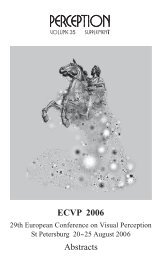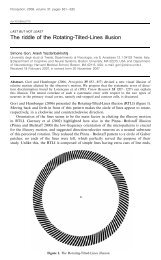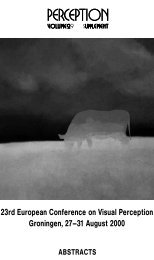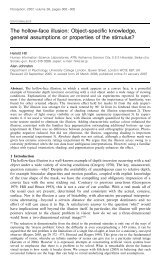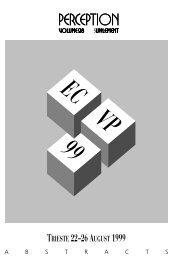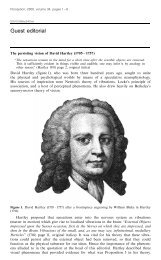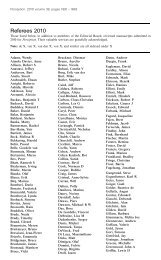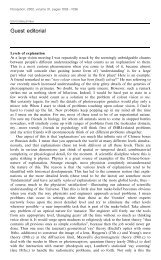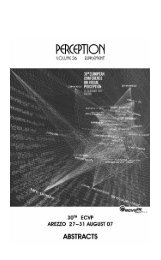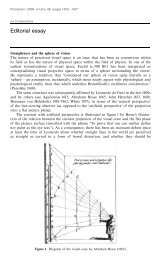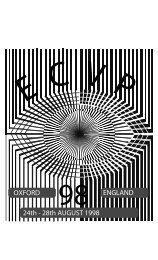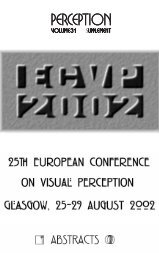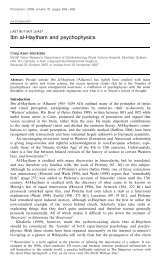Perceptual and cognitive characteristics of common playing cards
Perceptual and cognitive characteristics of common playing cards
Perceptual and cognitive characteristics of common playing cards
You also want an ePaper? Increase the reach of your titles
YUMPU automatically turns print PDFs into web optimized ePapers that Google loves.
Perception, 2012, volume 41, pages 268 ^ 286<br />
doi:10.1068/p7175<br />
<strong>Perceptual</strong> <strong>and</strong> <strong>cognitive</strong> <strong>characteristics</strong> <strong>of</strong> <strong>common</strong> <strong>playing</strong><br />
<strong>cards</strong><br />
Jay A Olson<br />
Department <strong>of</strong> Psychology, Simon Fraser University, 8888 University Drive, Burnaby, BC V5A 1S6,<br />
Canada; e-mail: jo@alumni.sfu.ca<br />
Alym A Amlani, Ronald A Rensink<br />
Department <strong>of</strong> Psychology, University <strong>of</strong> British Columbia, 2136 West Mall, Vancouver, BC V6T 1Z4,<br />
Canada; e-mail: rensink@psych.ubc.ca<br />
Received 6 November 2011, in revised form 8 February 2012; published online 17 April 2012<br />
Abstract. We examined the perceptual <strong>and</strong> <strong>cognitive</strong> <strong>characteristics</strong> <strong>of</strong> the <strong>playing</strong> <strong>cards</strong> <strong>common</strong>ly<br />
used in the Western world. Specifically, we measured their visibility, memorability, likability, <strong>and</strong><br />
verbal <strong>and</strong> visual accessibility. Based on visibility <strong>and</strong> memorability, four groups <strong>of</strong> <strong>cards</strong> were<br />
distinguished: the Ace <strong>of</strong> Spades, other Aces, number <strong>cards</strong>, <strong>and</strong> face <strong>cards</strong>. Within each <strong>of</strong> these<br />
groups, there were few differences due to value or suit. Based on likability <strong>and</strong> accessibility, three<br />
additional groups were distinguished: the Ace <strong>of</strong> Hearts, Queen <strong>of</strong> Hearts, <strong>and</strong> King <strong>of</strong> Hearts.<br />
Several interesting relations were found between how people remember, like, <strong>and</strong> access <strong>cards</strong>;<br />
some <strong>of</strong> these were similar to effects found in studies <strong>of</strong> visual perception, while others seemed<br />
entirely new. Our results demonstrate that rigorous examination <strong>of</strong> real-world stimuli can shed<br />
light on the perception <strong>of</strong> ordinary objects, as well as help us underst<strong>and</strong> why magic works in<br />
the mind.<br />
Keywords: magic, <strong>playing</strong> <strong>cards</strong>, visual perception, object perception, memory<br />
1 Introduction<br />
Imagine a magician presenting a series <strong>of</strong> <strong>playing</strong> <strong>cards</strong>. A spectator freely selects one<br />
<strong>of</strong> these. Without seeing the chosen card, the magician reveals its name, to the audience's<br />
amazement <strong>and</strong> delight. Spectators call this magic. Magicians call it forcingöalthough<br />
the choice felt completely free, the magician heavily influenced the spectator's decision.<br />
We want to know why forcing, <strong>and</strong> other principles <strong>of</strong> card magic, work.<br />
Magic tricks exploit how people think <strong>and</strong> perceive. The science <strong>of</strong> magic examines<br />
why such tricks worköwhat makes them magicalöin an effort to better underst<strong>and</strong><br />
the human mind. At least three areas <strong>of</strong> magic are relevant: illusions, misdirection,<br />
<strong>and</strong> forcing (Kuhn et al 2008). Illusions occur when perception diverges from reality.<br />
For example, a spectator may see a ball vanish in midair, when it really did not leave<br />
the magician's h<strong>and</strong> (Kuhn <strong>and</strong> L<strong>and</strong> 2006; Triplett 1900). Misdirection occurs when the<br />
magician directs the spectator's attention elsewhere. For example, the magician may<br />
direct attention to the left h<strong>and</strong> to conceal an object in the right. Studying illusions<br />
<strong>and</strong> misdirection has helped illuminate perception, attention, <strong>and</strong> social cues (Kuhn<br />
et al 2009). Studying forcing <strong>and</strong> related effects may have a similar impact.<br />
To our knowledge, however, no studies to date have systematically examined<br />
forcing, or most other card tricks. By doing so we can examine such things as which<br />
factorsöknowingly or unknowinglyöinfluence our decisions, <strong>and</strong> how these relate to<br />
the feeling <strong>of</strong> an uninfluenced, conscious choice. For example, will people more likely<br />
choose visually distinct stimuli over less distinct ones? Or choose more likable stimuli<br />
over less likable ones? More generally, the study <strong>of</strong> <strong>playing</strong> <strong>cards</strong> can also help explore<br />
issues such as the relation between the visibility <strong>and</strong> memorability <strong>of</strong> stimuli, or<br />
between likability <strong>and</strong> accessibility in long-term memory. In other words, studying card<br />
magic can help teach us about the human mind.
Playing <strong>cards</strong> 269<br />
The goal <strong>of</strong> this study, then, is to measure the perceptual <strong>and</strong> <strong>cognitive</strong> <strong>characteristics</strong><br />
<strong>of</strong> <strong>playing</strong> <strong>cards</strong> by adapting techniques used in <strong>cognitive</strong> <strong>and</strong> vision science.<br />
Measuring the perceptual <strong>characteristics</strong> <strong>of</strong> real-world stimuli has proven useful in areas<br />
such as information visualisation (eg, Clevel<strong>and</strong> et al 1982; Rensink <strong>and</strong> Baldridge 2010).<br />
We believe a similar approach will prove useful for <strong>playing</strong> <strong>cards</strong>.<br />
A typical Anglo-American deck consists <strong>of</strong> 52 <strong>cards</strong>, divided into four suits:<br />
Spades (S), Hearts (H), Clubs (C), <strong>and</strong> Diamonds (D). Each suit contains 13 values: an<br />
Ace (A), 9 number <strong>cards</strong> (2 to 10) <strong>and</strong> 3 face <strong>cards</strong> (Jack [J], Queen [Q], <strong>and</strong> King [K]).<br />
On the basis <strong>of</strong> visual similarity, three groups can be distinguished: Aces, number <strong>cards</strong>,<br />
<strong>and</strong> face <strong>cards</strong>.<br />
Although magicians rarely study <strong>cards</strong> experimentally, they have observed patterns<br />
based on performing tricks thous<strong>and</strong>s <strong>of</strong> times in real-world conditions. From these<br />
have arisen two additional distinctions: the Ace <strong>of</strong> Spades, which generally has a larger<br />
<strong>and</strong> unique pip (spot), <strong>and</strong> the Queen <strong>of</strong> Hearts, which many consider a popular card<br />
(eg Banachek 2000; Brown 2000).<br />
In this paper we investigated the perceptual <strong>and</strong> <strong>cognitive</strong> <strong>characteristics</strong> <strong>of</strong> these<br />
<strong>cards</strong>. In particular, we measured five factors that may affect the performance <strong>of</strong> a card<br />
in a magic trick:<br />
visibility: how well the card is identified in a brief display;<br />
memorability: how well it is remembered after being briefly presented;<br />
likability: how much it is preferred;<br />
verbal accessibility: how likely it is chosen when asked to name an arbitrary card;<br />
visual accessibility: how likely it is chosen when asked to visualise a card.<br />
These factors constitute a first approximation <strong>of</strong> how a <strong>playing</strong> card may be<br />
characterised psychologically. For example, do people treat (ie detect, remember, like,<br />
or access) the Ace <strong>of</strong> Spades differently from other Aces? Aces differently from number<br />
<strong>cards</strong>? Number <strong>cards</strong> differently from face <strong>cards</strong>? The Queen <strong>of</strong> Hearts differently<br />
from other Queens? Do value <strong>and</strong> suit interact with each other within these groups?<br />
Finally, do any <strong>of</strong> the five factors relate to each other? This paper provides a systematic<br />
approach to answering these questions. The results can serve as a useful guide for<br />
future studies <strong>of</strong> card magic, <strong>and</strong> as a method <strong>of</strong> investigating more general issues <strong>of</strong><br />
perception <strong>and</strong> cognition.<br />
2 Studies 1 ^ 3. General methods<br />
Studies 1, 2, <strong>and</strong> 3 measured visibility, memorability, <strong>and</strong> likability. In each experiment,<br />
a computer showed pictures <strong>of</strong> <strong>playing</strong> <strong>cards</strong> as part <strong>of</strong> a task. Each task took 10 to<br />
15 min, <strong>and</strong> participants completed the tasks individually.<br />
All three tasks shared a <strong>common</strong> structure as two-alternative forced-choice tasks.<br />
Participants first practised the task until they reported feeling comfortable with it.<br />
They then completed the actual task, following instructions to emphasise accuracy<br />
over speed. Half-way through each task, they took a short break to lessen fatigue.<br />
After finishing all three tasks, participants completed a questionnaire for demographic<br />
information, then received a debriefing. The order <strong>of</strong> the three tasks was balanced<br />
across participants. All experiments conformed to the university's ethical guidelines.<br />
2.1 Participants<br />
Ninety-six students at the University <strong>of</strong> British Columbia volunteered to complete the<br />
experiment for a choice <strong>of</strong> course credit or money. All had normal or corrected-to-normal<br />
vision.<br />
The sample consisted <strong>of</strong> sixty-two females <strong>and</strong> thirty-four males, with a median<br />
age <strong>of</strong> 21 years (M ˆ 22:5 years, SD ˆ 3:6 years). The typical participant spoke English
270 J A Olson, A A Amlani, R A Rensink<br />
primarily (n ˆ 64); first learned English (n ˆ 24), M<strong>and</strong>arin (n ˆ 20), or some unspecified<br />
Chinese dialect (n ˆ 18); played card games (n ˆ 62) suchasBigTwo(nˆ 21) about<br />
24 min per day (SD ˆ 34:2 min), <strong>and</strong> used the computer for 6.4 h per day (SD ˆ 3:6 h).<br />
One participant gave the same answer for every trial <strong>of</strong> the Memorability Task.<br />
We replaced these results with those <strong>of</strong> a new participant. The Likability Task used<br />
only half <strong>of</strong> our participants. This group differed only in age (M ˆ 21:5 years,<br />
SD ˆ 2:7 years) from the other half (M ˆ 23:4 years, SD ˆ 4:3 years).<br />
2.2 Apparatus <strong>and</strong> stimuli<br />
We used a poker-sized deck <strong>of</strong> Bicycle Playing Cards (United States Playing Card<br />
Company, Erlanger, KY, USA), with the <strong>cards</strong> scanned at 72 dots per inch. To make<br />
the scans <strong>of</strong> the <strong>cards</strong> appear uniform, we filled the background <strong>of</strong> each with a solid<br />
<strong>of</strong>f-white colour (RGB: 244, 241, 242), centred the card content (ie, the pattern <strong>of</strong><br />
pips), <strong>and</strong> rounded the corners. Each card therefore varied only in its pattern, <strong>and</strong> not<br />
in its background colour, size, or shape.<br />
For the practice phase <strong>of</strong> each task, we used Zener <strong>cards</strong>, which show only one<br />
symbol on each, such as a circle or a star. We believed that these <strong>cards</strong> would <strong>of</strong>fer a<br />
familiar set <strong>of</strong> stimuli for practice without affecting the performance <strong>of</strong> particular <strong>playing</strong><br />
<strong>cards</strong> (see Bruner <strong>and</strong> Postman 1949).<br />
The <strong>cards</strong> appeared on an Apple eMac G4/700 (Cupertino, CA, USA) with a<br />
screen measuring 33 deg625 deg <strong>of</strong> visual angle. Participants sat approximately 52 cm<br />
away from the screen. Each card measured 8 deg611 deg. A computer program (Crimsonite<br />
1.5 by Thomas Dang, 2009) displayed the <strong>cards</strong> on the screen <strong>and</strong> recorded the<br />
results. A script written in AWK (Aho et al 1987) h<strong>and</strong>led the counterbalancing <strong>and</strong><br />
r<strong>and</strong>omisation. All statistics used R, version 2.13.1 (R Core Development Team, 2011).<br />
3 Study 1: Visibility<br />
3.1 Procedure<br />
The Visibility Task measured the relative visibility <strong>of</strong> the various <strong>playing</strong> <strong>cards</strong>. The<br />
computer showed a stream <strong>of</strong> 26 <strong>cards</strong> while participants searched for a target cardö<br />
the independent variableöamong them. (This was based on a similar design involving<br />
other kinds <strong>of</strong> visual stimuli; see Potter 1976.) For example, participants would try to<br />
detect the Ace <strong>of</strong> Spades in a stream <strong>of</strong> <strong>cards</strong>, with accuracy as the dependent variable.<br />
(Henceforth, we will abbreviate card names by their value <strong>and</strong> suit [eg AS].)<br />
At the beginning <strong>of</strong> each trial, participants saw a target card for 1 s, followed by<br />
a rapid-serial visual presentation (RSVP) stream <strong>of</strong> <strong>cards</strong> (figure 1). Each card in<br />
this stream was displayed for 116 ms with a 0 ms interstimulus interval. Each card<br />
1s<br />
1s<br />
Target<br />
116 ms626<br />
Time<br />
Stream <strong>of</strong> <strong>cards</strong><br />
Card<br />
present?<br />
Press a key<br />
to continue<br />
1s<br />
Figure 1. Visibility Task design.
Playing <strong>cards</strong> 271<br />
appeared near the centre <strong>of</strong> the screen, with a r<strong>and</strong>om jitter <strong>of</strong> up to two pixels in<br />
any direction. This jitter made the stream look like individual <strong>cards</strong> being placed one<br />
atop the other, rather than a single card simply changing its content. After this, participants<br />
indicated whether they saw the target in the stream; chance performance was 50%.<br />
At the end <strong>of</strong> each trial, they pressed a key to continue to the next trial.<br />
Besides the target card, the stream contained r<strong>and</strong>omly selected distractor (non-target)<br />
<strong>cards</strong>, although never the pair card <strong>of</strong> the same value <strong>and</strong> colour as the target. For<br />
example, if the AS was the target, the distractors never included the other black Ace<br />
(ie the AC). This was intended to reduce variability in performance; no participants<br />
reported noticing this pattern. Overall, the target appeared in half <strong>of</strong> the trials.<br />
The target card never appeared in the first two nor last two positions in the<br />
stream, to reduce serial position effects (see Potter 1976) <strong>and</strong> to provide a mask for<br />
the target. We counterbalanced whether the target would appear in the first half <strong>of</strong> the<br />
stream (positions 3 to 13) or the second half (14 to 24). Within a given half, the target<br />
card appeared in a r<strong>and</strong>om position. Subsequent analyses showed that target position<br />
did not affect performance: neither within the first half <strong>of</strong> the stream (F10, 2485 ˆ 0:81,<br />
p ˆ 0:62); nor within the second half (F10 2485 ˆ 0:51, p ˆ 0:89); nor when comparing<br />
,<br />
the halves (F 1 4990 ˆ 0, p ˆ 0:97). Consequently, the experiment had a 52 (target card)<br />
,<br />
62 (target presence)62 (target position) design.<br />
Such a design would require 208 conditions per participant. To make the experiment<br />
length manageable, we presented each participant with half <strong>of</strong> the possible<br />
conditions: 104 trials. Each participant experienced every target card twice, with only<br />
one level <strong>of</strong> either target presence or target position group. Thus, some participants<br />
saw the AS as present in two trials, some as absent in two trials, <strong>and</strong> some as present<br />
once <strong>and</strong> absent once. This restriction was intended to prevent participants from guessing<br />
the next condition <strong>of</strong> the card <strong>and</strong> so improving at the task over time. Indeed,<br />
performance did not change across trials (F1 9982 ˆ 0:04, p ˆ 0:84).<br />
3.2 Analysis<br />
Detection accuracy was our main dependent variable. We calculated the hit rate (declaring<br />
a present target present) <strong>and</strong> false alarm rate (declaring an absent target present) for<br />
each card <strong>and</strong> for each participant. From these rates we calculated sensitivity <strong>and</strong> bias<br />
(Green <strong>and</strong> Swets 1966).<br />
Sensitivity (d 0 ) measures how well one can discriminate a target from a distractor set:<br />
for example, how well one can detect the AS among other <strong>cards</strong>. Higher values suggest<br />
better sensitivity. Bias or criterion (c) measures the bias in declaring a target absent,<br />
independent <strong>of</strong> sensitivity. Higher bias values indicate a higher probability <strong>of</strong> declaring<br />
a card absent, or stated differently, a higher threshold for declaring a card present.<br />
The d 0 <strong>and</strong> c values lack meaning when the hit or false alarm rates equal 0 or 1.<br />
Since calculating the values for each card <strong>and</strong> participant over only two trials <strong>of</strong>ten<br />
produces rates <strong>of</strong> 0 or 1, we grouped every four participants into supersubjects (see, eg,<br />
Crowder 1982), then calculated d 0 <strong>and</strong> c values for each <strong>of</strong> these 24 supersubjects. (1)<br />
In Study 1, we transformed the d 0 ,<br />
values to better fit a normal distribution. The<br />
raw values had a negative skew, so we reflected the distribution about the y-axis to<br />
create a positive skew. Next we shifted the distribution so that the minimum value was<br />
(1) We first calculated overall d 0 values for each participant. Then we sorted participants by this d 0<br />
<strong>and</strong> collapsed two sets <strong>of</strong> two participants with complementary data sets. Thus, each supersubject<br />
viewed every card in every condition twice, <strong>and</strong> consisted <strong>of</strong> four participants with similar overall<br />
d 0 s. We then calculated d 0 s for each card <strong>and</strong> supersubject, based on adjusted rates (see Macmillan<br />
<strong>and</strong> Kaplan 1985). This produced 24 d 0 s for each card, upon which we ran the rest <strong>of</strong> our analysis.<br />
We used an analogous procedure to analyse our c values, starting by sorting participants by overall c.<br />
The supersubject d 0 s<strong>and</strong>cs resembled those calculated on the participants as a whole, for both the<br />
Visibility <strong>and</strong> Memorability Tasks (all rs 4 0:98, all overall mean differences 50:04).
272 J A Olson, A A Amlani, R A Rensink<br />
positive, to allow for a log transformation. We then log-transformed the values to<br />
minimise the skew. These transformations changed no decisions about the null hypotheses.<br />
We thus plot the untransformed values for ease <strong>of</strong> interpretation.<br />
For all <strong>of</strong> the studies, we examined how performance differed between the five<br />
card groups distinguished by magicians: the AS, other Aces, number <strong>cards</strong>, face <strong>cards</strong>,<br />
<strong>and</strong> QH. For this we used a one-way ANOVA with supersubject in the error term.<br />
Next, within each card group, we examined how card value <strong>and</strong> suit affected performance.<br />
For this we used a two-way ANOVA with supersubject in the error term. Both<br />
types <strong>of</strong> tests used the Bonferroni correction, <strong>and</strong> we report the p <strong>and</strong> per-test a values<br />
(see Perneger 1998).<br />
3.3 Results <strong>and</strong> discussion<br />
3.3.1 Accuracy. Overall, participants could detect <strong>cards</strong> in a stream easily. They<br />
answered 80% <strong>of</strong> the trials correctly, with a hit rate <strong>of</strong> 75% (range 38% to 100%,<br />
SD ˆ 14:15%) <strong>and</strong> a false alarm rate <strong>of</strong> 15% (range 0% to 65%, SD ˆ 11:78%). Across<br />
all <strong>cards</strong>, participants showed an average sensitivity <strong>of</strong> 1.25 (SD ˆ 0:14) <strong>and</strong> bias <strong>of</strong><br />
0.16 (SD ˆ 0:11).<br />
3.3.2 Questionnaire. The post-test questionnaire asked whether participants used any<br />
strategies during the task. Most <strong>of</strong> them did (n ˆ 56). Many (n ˆ 34) reported watching<br />
the upper-left pip <strong>of</strong> the card, <strong>and</strong> some (n ˆ 9) reported only observing the general<br />
pattern <strong>of</strong> the card.<br />
3.3.3 Sensitivity. Between card groups, visibility sensitivity varied considerably (figure<br />
2a). Participants detected the AS better than other Aces. The AS has a large <strong>and</strong> unique<br />
pip, making it distinct from every card <strong>and</strong> presumably aiding detection. Participants<br />
also detected other Aces better than number <strong>cards</strong>. Aces show the simplest patternö<br />
one pip in the middleömaking them look distinct from number <strong>cards</strong>, perhaps again<br />
aiding detection. No other differences were found. Interestingly, face <strong>cards</strong> were no<br />
more detectable than number <strong>cards</strong>, despite their more extensive <strong>and</strong> varied colours.<br />
(See the Visibility d 0 row <strong>of</strong> table 1 for means.) Within card groups, sensitivity did<br />
not differ by value or suit. (For ANOVA results see table A1 in the online appendix at<br />
http://dx.doi.org/10.1068/p7175)<br />
Sensitivity (d 0 )<br />
1.6<br />
1.4<br />
1.2<br />
1.0<br />
A 2 3 4 5 6 7 8 9 10 J Q K A 2 3 4 5 6 7 8 9 10 J Q K<br />
Card value Card value<br />
(a) (b)<br />
Bias (c)<br />
Figure 2.Visibility sensitivity (a) <strong>and</strong> bias (b) by card value. Lines <strong>and</strong> boxes demarcate card groups,<br />
as in subsequent graphs.<br />
0.4<br />
0.3<br />
0.2<br />
0.1<br />
0.0
Playing <strong>cards</strong> 273<br />
Table 1. Mean sensitivity (d 0 ), bias (c), <strong>and</strong> proportions across groups <strong>of</strong> <strong>playing</strong> <strong>cards</strong>.<br />
Study Measure AS Other Number Face QH Other<br />
Aces a <strong>cards</strong> <strong>cards</strong> b Queens c<br />
Visibility d 0<br />
1.76 4 1.31 4 1.23 ˆ 1.26 1.21 ˆ 1.19<br />
c 0.08 ˆ 0.19 ˆ 0.16 ˆ 0.15 0.13 ˆ 0.14<br />
Memorability d 0<br />
1.43 4 0.85 4 0.59 ˆ 0.69 0.74 ˆ 0.68<br />
c 0.21 ˆ 0.12 ˆ 0.29 4 0.03 0.06 ˆ 0<br />
Likability P(prefer) d 0.77 4 0.62 4 0.46 5 0.54 0.69 4 0.49<br />
Verbal Accessibility P(choose) 0.246 4 0.039 4 0.007 5 0.022 0.137 4 0.016<br />
Visual Accessibility P(choose) 0.173 4 0.049 4 0.011 5 0.017 0.1 4 0.013<br />
Note: Equality <strong>and</strong> inequality symbols between columns show decisions about corresponding<br />
means. See respective ANOVA tables for statistics.<br />
a Other Aces refers to the average <strong>of</strong> the AH, AC, <strong>and</strong> AD, in this table <strong>and</strong> throughout.<br />
b Excludes the QH.<br />
c Other Queens refers to the average <strong>of</strong> the QS, QC, <strong>and</strong> QD. We did not treat this as a separate<br />
card group, but used it for comparing the QH.<br />
d Mean preference given two choices. For example, when shown the AS <strong>and</strong> another card, 77%<br />
will prefer the former.<br />
3.3.4 Bias. Unlike sensitivity, bias did not differ between card groups (figure 2b). (See<br />
the Visibility c row <strong>of</strong> table 1 for means.) Within card groups, bias depended only<br />
on the suit <strong>of</strong> number <strong>cards</strong> (figure 3). (2) An interesting finding was that participants<br />
seemed more likely to declare Spades absent compared to other suits. This did not<br />
seem to result from any outliers: the biases <strong>of</strong> almost all Spade number <strong>cards</strong> exceeded<br />
those <strong>of</strong> other suits (figure 2b). It is unclear why this would occur. (See table A2 for<br />
ANOVA results.)<br />
Two outliers were also found: the red Sixes (6H <strong>and</strong> 6D). These two seemed to<br />
have the lowest biases <strong>of</strong> all <strong>cards</strong> (figure 2b). In other words, people seemed most<br />
likely to declare red Sixes present when they were absent, compared to any other <strong>cards</strong>.<br />
Some magic tricks exploit the similarity <strong>of</strong> appearance <strong>of</strong> Hearts <strong>and</strong> Diamonds, <strong>and</strong><br />
between Sixes <strong>and</strong> Nines. Beyond this, it is unclear why people would misreport seeing<br />
red Sixes.<br />
Mean bias (c)<br />
0.5<br />
0.4<br />
0.3<br />
0.2<br />
0.1<br />
0.0<br />
Spades Hearts Clubs Diamonds<br />
Suit<br />
Figure 3. Mean visibility bias by suit <strong>of</strong> number<br />
card.<br />
(2) Error bars in all plots show 95% confidence intervals, by convention <strong>and</strong> for comparing different<br />
plots. Note that these 95% intervals suggest a per-test a <strong>of</strong> 0.05, which we did not use for all<br />
hypotheses. See the corresponding ANOVA tables throughout for per-test a values.
274 J A Olson, A A Amlani, R A Rensink<br />
4 Study 2: Memorability<br />
The Memorability Task measured how well participants could remember a card that<br />
was briefly displayed in an RSVP stream. Its design was in many ways the converse <strong>of</strong><br />
the Visibility Task: first participants saw a stream <strong>of</strong> <strong>cards</strong>, then a target card appeared.<br />
At the beginning <strong>of</strong> each trial, participants saw an RSVP stream <strong>of</strong> seven <strong>cards</strong>,<br />
each for 250 ms with a 0 ms interstimulus interval (figure 4). Each card had a slight<br />
jitter in position, as in the Visibility Task. Participants then saw the target card for<br />
1 s, after which they indicated whether they saw it in the stream. Like the Visibility<br />
Task, the Memorability Task had 104 trials, using each card as the target twice, <strong>and</strong><br />
the target was present in half <strong>of</strong> the trials. Again, accuracy was the dependent variable,<br />
with chance performance at 50%.<br />
1s<br />
In the stream <strong>of</strong> seven <strong>cards</strong>, the target never appeared in the first position nor last<br />
two positions. (3) The target, then, had four possible positions (viz 2 through 5), <strong>and</strong><br />
appeared equally in the first half (positions 2 <strong>and</strong> 3) <strong>and</strong> second half (4 <strong>and</strong> 5).<br />
Within a given half, the target card appeared in a r<strong>and</strong>om position. Target position did<br />
not affect performance: neither within the first half <strong>of</strong> the stream (F1, 2494 ˆ 0:04,<br />
p ˆ 0:84); nor within the second half (F1 2494 ˆ 0:95, p ˆ 0:33); nor when comparing<br />
,<br />
the halves, F 1 4990 ˆ 1:38, p ˆ 0:24). Consequently, the experiment had a 52 (target card)<br />
,<br />
62 (target presence)62 (target position) design.<br />
The rest <strong>of</strong> the stream included r<strong>and</strong>om <strong>cards</strong>, excluding the target's pair card.<br />
The six distractors included at least one card from each suit (S, H, C, D) <strong>and</strong> value<br />
group (A ^ 3, 4 ^ 6, 7 ^ 10, J ^ K). We believed that including a stratified sample <strong>of</strong><br />
distractors would reduce the participants' likelihood <strong>of</strong> inferring (non-existent) patterns<br />
<strong>and</strong> so extraneously affecting performance. Indeed, no participants reported seeing<br />
patterns in the series <strong>of</strong> <strong>cards</strong>, <strong>and</strong> performance remained constant across trials<br />
(F1 9982 ˆ 1:02, p ˆ 0:31).<br />
,<br />
250 ms67<br />
Time<br />
1s<br />
Stream <strong>of</strong> <strong>cards</strong><br />
Card present?<br />
Target<br />
Press a key<br />
to continue<br />
1s<br />
Figure 4. Memorability Task design.<br />
(3) Pilot studies revealed serial position effects in these positions; avoiding them decreased extraneous<br />
variability in performance. Follow-up pilot studies indicated that knowledge <strong>of</strong> the excluded<br />
positions did not substantially improve performance. Only 5 <strong>of</strong> the 96 participants reported having<br />
observed this pattern when asked in the questionnaire if they `noticed anything'. These five participants<br />
seemed to perform better than average, but their performance did not change throughout the<br />
trials, so this did not present a confound.
Playing <strong>cards</strong> 275<br />
4.1 Results <strong>and</strong> discussion<br />
4.1.1 Accuracy. Overall, participants had more trouble remembering <strong>cards</strong> in a stream<br />
than they did detecting them (Study 1). They answered 66% <strong>of</strong> the trials correctly,<br />
with a hit rate <strong>of</strong> 58% (range 0% to 96%, SD ˆ 16:72%) <strong>and</strong> a false alarm rate <strong>of</strong> 27%<br />
(range 4% to 69%, SD ˆ 13:47). Across all <strong>cards</strong>, participants showed an average<br />
sensitivity <strong>of</strong> 0.65 (SD ˆ 0:19) <strong>and</strong> bias <strong>of</strong> 0.22 (SD ˆ 0:16).<br />
4.1.2 Questionnaire. Most participants (n ˆ 57) reported using strategies during the<br />
task. Almost half <strong>of</strong> these (n ˆ 26) reported watching the upper-left pip <strong>of</strong> the card,<br />
<strong>and</strong> many others (n ˆ 20) focused on the value rather than the suit.<br />
4.1.3 Sensitivity. Between card groups, memorability sensitivity varied considerably<br />
(figure 5a). Participants remembered the AS better than other Aces, <strong>and</strong> other Aces better<br />
than number <strong>cards</strong>. Presumably the distinctiveness <strong>of</strong> the AS pip, <strong>and</strong> the distinctiveness<br />
<strong>of</strong> the simplicity <strong>of</strong> the Aces made them more memorable. No other differences were<br />
found. (See the Memorability d 0 row <strong>of</strong> table 1 for means.)<br />
Within card groups, sensitivity did not differ, by value or suit. All <strong>of</strong> these patterns<br />
resembled the results <strong>of</strong> the Visibility Task. (See table A3 for ANOVA results.)<br />
Sensitivity (d 0 )<br />
1.4<br />
1.2<br />
1.0<br />
0.8<br />
0.6<br />
0.4<br />
A 2 3 4 5 6 7 8 9 10 J Q K A 2 3 4 5 6 7 8 9 10 J Q K<br />
(a)<br />
Card value<br />
(b)<br />
Card value<br />
Figure 5. Memorability sensitivity (a) <strong>and</strong> bias (b) by card value.<br />
Bias (c)<br />
4.1.4 Bias. Between card groups, bias was higher for number <strong>cards</strong> than face <strong>cards</strong><br />
(figure 5b). In other words, participants would more likely declare number <strong>cards</strong> absent<br />
than they would face <strong>cards</strong>. No other differences were found. (See the Memorability c<br />
row <strong>of</strong> table 1 for means.)<br />
Within card groups, bias depended only on the value <strong>of</strong> number <strong>cards</strong> (figure 6).<br />
In particular, as the value <strong>of</strong> the number card increased to four, participants seemed<br />
more likely to declare it absent. This was unlikely to be entirely due to visual factors,<br />
since visibility did not show a similar pattern. The steady increase <strong>of</strong> bias from two<br />
to four pips may relate to subitisingöthe ability to rapidly enter up to four items<br />
into short-term memory (eg Trick <strong>and</strong> Pylyshyn 1994). For higher numbers <strong>of</strong> pips,<br />
participants may have felt less confident, as they may have needed more time to<br />
count or would have required use <strong>of</strong> a cruder number sense (eg Lemer et al 2003).<br />
As such, participants would more likely declare them absent. (See table A4 for ANOVA<br />
results.)<br />
0.5<br />
0.4<br />
0.3<br />
0.2<br />
0.1<br />
0.0<br />
0.1
276 J A Olson, A A Amlani, R A Rensink<br />
Mean bias (c)<br />
0.5<br />
0.4<br />
0.3<br />
0.2<br />
0.1<br />
0.0<br />
2 3 4 5 6 7 8 9 10<br />
Number<br />
5 Study 3: Likability<br />
The Likability Task measured the emotional valence <strong>of</strong> each card: how much participants<br />
liked it. Each trial presented a pair <strong>of</strong> <strong>cards</strong> side by side <strong>and</strong> asked participants to<br />
choose the one they liked more. The <strong>cards</strong> remained visible until the participants<br />
responded by pressing the key corresponding to the left or right card. The next trial<br />
started 300 ms later.<br />
Each participant saw 156 trials, consisting <strong>of</strong> two intermixed sets. The first comprised<br />
all pairwise comparisons <strong>of</strong> every different suit for each value. For example, participants<br />
saw suit comparisons <strong>of</strong> Aces (AS ^ AH, AS ^ AC, etc), then <strong>of</strong> Twos (2S ^ 2H, 2S ^ 2C,<br />
etc), <strong>and</strong> so on. Given 6 suit combinations for each <strong>of</strong> the 13 values, this required<br />
78 trials.<br />
The second set comprised all value comparisons within a suit. Each participant<br />
saw only one suit, <strong>and</strong> the selection <strong>of</strong> suit was counterbalanced across participants.<br />
For example, the first participant saw all value comparisons <strong>of</strong> Spades (AS ^ 2S,<br />
AS ^ 3S, etc), the next saw all value comparisons <strong>of</strong> Hearts (AH ^ 2H, AH ^ 3H, etc),<br />
<strong>and</strong> so on. This also required 78 trials.<br />
Overall, each card appeared an equal number <strong>of</strong> times, <strong>and</strong> equally on the left <strong>and</strong><br />
right side <strong>of</strong> the screen. To do this, the <strong>cards</strong> appeared in one permutation (eg AS ^ 2S)<br />
for half <strong>of</strong> the participants <strong>and</strong> the reverse (eg 2S ^ AS) for the other half. Participants<br />
showed a slight preference for <strong>cards</strong> on the right side <strong>of</strong> the screen: 52% preferred <strong>cards</strong><br />
on the right side (t7487 ˆ 3:56, p 5 0:001). This preference increased only slightly over<br />
trials (F1 7486 ˆ 5:23, p ˆ 0:02, b1 ˆ 0:001).<br />
5.1 Analysis<br />
The dependent variable was preference: the probability <strong>of</strong> a given card being preferred.<br />
This ranged from 0 to 1, with 0.5 meaning that the card was preferred half <strong>of</strong> the time<br />
it was displayed. Our analyses used Bonferroni-corrected Pearson's w 2 tests on the raw<br />
frequency data.<br />
5.2 Results <strong>and</strong> discussion<br />
5.2.1 Questionnaire. Most participants (n ˆ 38) reported using strategies during the<br />
task. (4) ,<br />
Many <strong>of</strong> them (n ˆ 28) used a specific rule for preference, based on a preferred<br />
card or set <strong>of</strong> <strong>cards</strong>. Some reported preferring higher-valued <strong>cards</strong> (n ˆ 10);<br />
(4) Recall that the Likability Task used only 48 participants.<br />
Figure 6. Mean memorability bias by number<br />
card value.
Playing <strong>cards</strong> 277<br />
others preferred lower <strong>cards</strong> (n ˆ 3) or those with a simpler pattern (n ˆ 3). Two<br />
reported preferring <strong>cards</strong> based on their rank in the game Big Two. (5)<br />
5.2.2 Preference. Between card groups, preference differed considerably (figure 7). Participants<br />
preferred the AS over other Aces, perhaps due to its popularity or high rank in<br />
card games. They also preferred other Aces over number <strong>cards</strong>, perhaps due to their<br />
simple pattern <strong>and</strong> high rank. As opposed to some <strong>of</strong> the patterns found for visibility<br />
<strong>and</strong> memorability, face <strong>cards</strong> <strong>and</strong> number <strong>cards</strong> could now be distinguished, perhaps<br />
partly due to their higher rank or colourful pictures. They also preferred the QH over<br />
other Queens, but perhaps only due to its highly liked suit. Indeed, the QH did not<br />
seem like an extreme outlier (figure C1). (See the Likability row <strong>of</strong> table 1 for means.)<br />
Preference<br />
0.7<br />
0.6<br />
0.5<br />
0.4<br />
A 2 3 4 5 6 7 8 9 10 J Q K<br />
Card value<br />
Figure 7. Preference by card value.<br />
Within card groups, preference depended on both value <strong>and</strong> suit. For value, participants<br />
seemed to like Twos <strong>and</strong> Tensöthe highest <strong>and</strong> the lowest valuesöthe most,<br />
<strong>and</strong> the rest <strong>of</strong> the values equally (figure C2). The questionnaire responses suggest two<br />
possible explanations. First, participants <strong>of</strong>ten reported liking high or low <strong>cards</strong> versus<br />
middle-valued <strong>cards</strong>. Second, many participants played Big Two <strong>and</strong> some reported<br />
preferring high-ranking <strong>cards</strong> in the game: namely, Twos, <strong>and</strong> higher number <strong>cards</strong>.<br />
Indeed, players <strong>of</strong> Big Two seemed to prefer Twos more than non-players did (figure 8).<br />
For suit, participants seemed to show a general pattern <strong>of</strong> preferring Spades <strong>and</strong><br />
Hearts over Clubs <strong>and</strong> Diamonds across all card groups (figures C3, C4, <strong>and</strong> C5).<br />
This may have occurred due to their rank in card games (eg in the card game Hearts).<br />
Or, perhaps it occurred because people prefer curved shapes (Bar <strong>and</strong> Neta 2006): Spades<br />
<strong>and</strong> Hearts have more curved shapes compared to the less smooth shape <strong>of</strong> Clubs <strong>and</strong><br />
sharp shape <strong>of</strong> Diamonds. People also prefer simple shapes (Day 1967), <strong>and</strong> Clubs have<br />
a particularly complex shape compared to the other suits, perhaps making it the least<br />
liked suit.<br />
(5) In Big Two, card values rank from highest to lowest as Twos, Aces, Kings, Queens, Jacks, <strong>and</strong> Tens,<br />
down to Threes. Suits rank as Spades, Hearts, Clubs, then Diamonds.
278 J A Olson, A A Amlani, R A Rensink<br />
Mean preference<br />
Finally, preference within face <strong>cards</strong> depended on the interaction <strong>of</strong> value<br />
<strong>and</strong> suit (figure C1). In other words, participants seemed to like particular face<br />
<strong>cards</strong> more than others. Face <strong>cards</strong> vary considerably in their patterns <strong>and</strong><br />
colours, <strong>and</strong> also in the expression on the faces. Subtle changes in expression<br />
may have affected preference (Lundqvist et al 1999), along with the larger changes<br />
in pattern.<br />
There were two unexpected outliers: the AH <strong>and</strong> KH (figure 7). Perhaps the interaction<br />
<strong>of</strong> the highly liked value <strong>and</strong> highly liked suit made participants particularly<br />
prefer these <strong>cards</strong>.<br />
We also saw some gender differences. Women seemed to prefer lower-valued<br />
<strong>cards</strong> more, <strong>and</strong> men higher-valued ones (figure 9). Indeed, in the questionnaire<br />
more men (28%) reported liking higher values, <strong>and</strong> no men reported liking lower<br />
values. Women did not show this pattern: the same amount (13%) reported liking<br />
lower <strong>and</strong> higher values. This did not seem to be due to differences in their favourite<br />
card game. Regardless <strong>of</strong> the game, most women preferred lower values, <strong>and</strong> most<br />
men higher values.<br />
Mean preference<br />
0.8<br />
0.7<br />
0.6<br />
0.5<br />
0.4<br />
0.3<br />
A 2 3 4 5 6 7 8 9 10 J Q K A 2 3 4 5 6 7 8 9 10 J Q K<br />
(a)<br />
Card value<br />
(b)<br />
Card value<br />
Figure 8. Mean preference for card values in players (a; n ˆ 11) <strong>and</strong> non-players (b; n ˆ 37) <strong>of</strong><br />
Big Two. Gender proportions were similar for both groups.<br />
0.8<br />
0.7<br />
0.6<br />
0.5<br />
0.4<br />
0.3<br />
A 2 3 4 5 6 7 8 9 10 J Q K A 2 3 4 5 6 7 8 9 10 J Q K<br />
Card value Card value<br />
(a) (b)<br />
Figure 9. Mean preference for card values in women (a; n ˆ 31) <strong>and</strong> men (b; n ˆ 17).
Playing <strong>cards</strong> 279<br />
6 Study 4: Verbal Accessibility<br />
As mentioned earlier, magicians will <strong>of</strong>ten ask spectators to verbally choose any card.<br />
The Verbal Accessibility study therefore measured a factor critical to such tricks: how<br />
likely a card will come to mind when the spectator is asked to name an arbitrary<br />
card. R A Fisher (1928), for example, observed that people show tendencies to name<br />
particular <strong>cards</strong> when trying to guess a card r<strong>and</strong>omly drawn from a deck. Woolley<br />
(1928) reported that people <strong>of</strong>ten choose Acesöespecially the ASö<strong>and</strong> odd <strong>cards</strong><br />
when trying to do this. Banachek (2000) constructed a list <strong>of</strong> frequently chosen <strong>cards</strong>,<br />
based on ``trial <strong>and</strong> error'' as part <strong>of</strong> a magic trick asking spectators to name a<br />
card (personal communication, 2009). His <strong>and</strong> other magicians' lists prioritise Aces,<br />
face <strong>cards</strong>, <strong>and</strong> certain low number <strong>cards</strong> (table 2). We measured the accessibility <strong>of</strong><br />
<strong>playing</strong> <strong>cards</strong> in a similar, but more systematic, way.<br />
Table 2. Frequently chosen <strong>cards</strong>.<br />
Source Cards<br />
Banachek 2000a AS, QH, AH, KH, JS, AD, QS, JD, 3S, 3H, 10H<br />
Verbal Accessibility (Study 4) b AS; QH; AH; KH; JS; AD; JH; KS; QS, JD, QD, 7H<br />
Visual Accessibility (Study 5) b AS; AH; QH; KH; 3D; JS, 5H, 8C; AD; 8S, 10H, JH<br />
Magic contextc AS, AH; KH; QH, QD, 2H<br />
Note: Commas separate tiesÐ<strong>cards</strong> chosen the same number <strong>of</strong> times. Semicolons do not.<br />
a Cards sorted to match verbal accessibility data, since frequencies were not provided.<br />
b Top-quartile data.<br />
c Cards chosen more than once.<br />
6.1 Methods<br />
6.1.1 Procedure. We asked participants to name an arbitrary card, using two analogous<br />
procedures: in-person <strong>and</strong> online. We collected the in-person data at a lab <strong>and</strong> a local<br />
science centre. At the lab, we recruited participants arriving for other experiments;<br />
at the science centre, we recruited visitors aged over 18 years. For both procedures,<br />
we tried to avoid words that might prime specific numbers. For example, claiming that<br />
the questionnaire will ``ask a few questions'' might prime numbers corresponding to<br />
`few', such as two or three (eg Brown 2000; Kubovy 1977). Even claiming that ``we are<br />
going to ask questions'' might prime the homonym `two' (eg Lesch <strong>and</strong> Pollatsek<br />
1993). We instead tried to maintain a more neutral wording. We asked the following:<br />
``We're doing a study on <strong>playing</strong> <strong>cards</strong>. May I ask you questions about <strong>cards</strong>? (If yes:)<br />
Name a <strong>playing</strong> card. Was that the first card that came to mind? Have you been asked<br />
these questions before? What is your age (not m<strong>and</strong>atory)?''<br />
The experimenter also recorded the participant's gender, then explained the study.<br />
The online version used a questionnaire split over several pages. The first page<br />
stated, ``We're doing a study on <strong>playing</strong> <strong>cards</strong>. This questionnaire will ask you questions<br />
about <strong>cards</strong>.'' After clicking `Next', the website asked to ``Name a <strong>playing</strong> card'' <strong>and</strong> gave<br />
an empty field in which to type the name <strong>of</strong> a card (eg Àce <strong>of</strong> Spades'). We then asked<br />
the same questions as the in-person procedure with the addition <strong>of</strong> gender.<br />
6.1.2 Participants. In total, we asked 667 participants to name a card. The in-person<br />
group (n ˆ 147) hadamedianage<strong>of</strong>22years(Mˆ 26:6 years, SD ˆ 11:2 years), <strong>and</strong><br />
consisted <strong>of</strong> 56% women <strong>and</strong> 44% men. The online group (n ˆ 520) consisted primarily <strong>of</strong><br />
undergraduate psychology students who learned about the questionnaire through e-mail.<br />
They had a median age <strong>of</strong> 22 years (M ˆ 29:9 years, SD ˆ 14:2 years) <strong>and</strong> consisted<br />
<strong>of</strong> 33% women <strong>and</strong> 66% men.
280 J A Olson, A A Amlani, R A Rensink<br />
6.1.3 Analysis. For all responses, we first omitted participants who reported having<br />
previously completed a similar questionnaire (n ˆ 36). We then omitted those who<br />
reported choosing a card different from the first one that came to mind (n ˆ 87). For<br />
the in-person data, we omitted those participants who paused for more than two seconds<br />
before answering, or who first said anything other than a <strong>playing</strong> card (n ˆ 21).<br />
We passed the online responses through a parser which matched the inputted text<br />
(eg Àce <strong>of</strong> Spades') to a <strong>playing</strong> card. The parser looked for <strong>common</strong> misspellings<br />
(eg `Dimond' for `Diamond') <strong>and</strong> alternate names (eg `Clover' for `Club'). It omitted<br />
responses describing non-<strong>cards</strong> (eg `Joe'), ambiguous <strong>cards</strong> (eg `Queen'), <strong>and</strong> Jokers. We<br />
ended up with 423 (113 in-person, 310 online) valid responses. This subset <strong>of</strong> participants<br />
had a median age <strong>of</strong> 23 years (M ˆ 29:4 years, SD ˆ 14:8 years), <strong>and</strong> consisted <strong>of</strong> 39%<br />
women <strong>and</strong> 61% men.<br />
People generally chose the same <strong>cards</strong> in person <strong>and</strong> online. We found a high<br />
Spearman's rank correlation between these data sets (rS ˆ 0:61) <strong>and</strong> so combined<br />
them. The dependent variable, then, was the probability <strong>of</strong> choosing a particular card.<br />
As in the Likability Task, our analyses used Bonferroni-corrected Pearson's w 2 tests on<br />
the raw frequency data.<br />
6.2 Results <strong>and</strong> discussion<br />
Participants showed strong tendencies to verbally select particular <strong>cards</strong> (figure 10a).<br />
Between <strong>and</strong> within card groups, they showed the same pattern <strong>of</strong> results as in the<br />
Likability Task (cf tables A5 <strong>and</strong> A6). The AS was by far the most chosen, followed by<br />
the QH, <strong>and</strong> then other high-ranking <strong>cards</strong> (see the Verbal Accessibility row <strong>of</strong> table 2).<br />
(See the Verbal Accessibility row <strong>of</strong> table 1 for means, <strong>and</strong> table A6 for w 2 results.)<br />
Proportion named<br />
0.20<br />
0.15<br />
0.10<br />
0.05<br />
0.00<br />
A 2 3 4 5 6 7 8 9 10 J Q K A 2 3 4 5 6 7 8 9 10 J Q K<br />
(a)<br />
Card value<br />
(b)<br />
Card value<br />
Figure 10. Proportion named (a; N ˆ 423) <strong>and</strong> visualised (b; N ˆ 450; Study 5) by card value.<br />
Choice <strong>of</strong> card depended on value only within number <strong>cards</strong> (figure 11a). Participants<br />
named Threes <strong>and</strong> Sevens the most, <strong>and</strong> Sixes the least. Magicians have noticed<br />
that people <strong>of</strong>ten choose three <strong>and</strong> seven when asked in magic tricks to choose a<br />
number out <strong>of</strong> five or ten, respectively (Banachek 2000). Likewise, researchers have<br />
found that people tend to choose three or seven the most when asked to pick the first<br />
digit that comes to mind (Kubovy 1977; Kubovy <strong>and</strong> Psotka 1976).<br />
Choice also depended on suit. Participants seemed to show a pattern <strong>of</strong> choosing<br />
Spades or Hearts the most (figures C6, C7, <strong>and</strong> C8), again following the pattern found<br />
in the Likability Task.<br />
Proportion visualised
Playing <strong>cards</strong> 281<br />
Mean proportion named<br />
0.020<br />
0.015<br />
0.010<br />
0.005<br />
0.000<br />
0.000<br />
2 3 4 5 6 7 8 9 10 2 3 4 5 6 7 8 9 10<br />
(a) Number (b)<br />
Number<br />
Figure 11. Mean proportion <strong>of</strong> number <strong>cards</strong> named (a) <strong>and</strong> visualised (b; Study 5) by value.<br />
Finally, choice depended on the interaction <strong>of</strong> value <strong>and</strong> suit, within face <strong>cards</strong><br />
(figure C9). Again, as in the Likability Task, the AH <strong>and</strong> KH were outliers, though<br />
less extreme ones (figure 10a).<br />
We also saw some gender differences. One may expect women to choose the QH more<br />
frequently (eg Banachek 2000), <strong>and</strong> men the KH, given the gender <strong>of</strong> the characters<br />
on the <strong>cards</strong>. Interestingly, we saw the opposite pattern (figure 12a).<br />
Proportion named (women)<br />
0.20<br />
0.15<br />
0.10<br />
0.05<br />
Proportion visualised (women)<br />
Mean proportion visualised<br />
6.3 Generalisability<br />
Our list <strong>of</strong> frequently chosen <strong>cards</strong> corresponded fairly well to those obtained by<br />
magicians. For example, 8 <strong>of</strong> Banachek's 11 frequently chosen <strong>cards</strong> matched our<br />
top-quartile data (cf the Banachek <strong>and</strong> Verbal Accessibility rows <strong>of</strong> table 2). Nevertheless,<br />
our results may have diverged somewhat from those <strong>of</strong> other magicians because<br />
our study lacked a magic contextöthe card choices did not occur as part <strong>of</strong> a magic<br />
trick. To test our results in a more natural environment, we approached 30 studentaged<br />
groups <strong>of</strong> people over two nights at a bar. We presented a magic trick in which<br />
the spectator would name an arbitrary card; we did not mention the research until<br />
after the trick. Of the six <strong>cards</strong> chosen more than once, five corresponded to our top<br />
accessibility rankings. (See the Magic context row <strong>of</strong> table 2.) Our results thus seem to<br />
represent choices made in a magic context, at least for people in this region <strong>and</strong> age group.<br />
0.030<br />
0.025<br />
0.020<br />
0.015<br />
0.010<br />
0.005<br />
0.00<br />
0.00<br />
0.00 0.05 0.10 0.15 0.20 0.00 0.02 0.04 0.06 0.08 0.10<br />
Proportion named (men) Proportion visualised (men)<br />
(a) (b)<br />
Figure 12. Verbal (a) <strong>and</strong> visual (b; Study 5) accessibility in women <strong>and</strong> men.<br />
0.07<br />
0.06<br />
0.05<br />
0.04<br />
0.03<br />
0.02<br />
0.01
282 J A Olson, A A Amlani, R A Rensink<br />
7 Study 5: Visual Accessibility<br />
The Visual Accessibility study explored whether people choose <strong>cards</strong> differently if<br />
asked to visualise rather than name them. Differences are known to exist between<br />
verbal <strong>and</strong> non-verbal encoding <strong>of</strong> stimuli (eg Paivio 1991). When asked to visualise<br />
a <strong>playing</strong> card, people might visually construct a card rather than simply retrieve a<br />
verbal label, <strong>and</strong> thus might tend to choose different types <strong>of</strong> <strong>cards</strong>.<br />
7.1 Methods<br />
7.1.1 Procedure. We used the same online procedure as in Study 4, except that rather<br />
than asking people to ``Name a <strong>playing</strong> card'', they were asked to ``Visualise a <strong>playing</strong><br />
card. . . . What is it?''.<br />
7.1.2 Participants. We began with 700 participants, who consisted primarily <strong>of</strong> undergraduate<br />
psychology students who learned about the questionnaire through e-mail.<br />
They had a median age <strong>of</strong> 21 years (M ˆ 25:5 years, SD ˆ 10:5 years), <strong>and</strong> consisted<br />
<strong>of</strong> 43% women <strong>and</strong> 57% men.<br />
As in Study 4, we omitted participants who reported participating in a similar<br />
experiment (n ˆ 67) <strong>and</strong> those who reported that another card came to mind first<br />
(n ˆ 120). We passed the data through the same parser <strong>and</strong> ended up with 450 valid<br />
responses. This subset <strong>of</strong> the participants had a median age <strong>of</strong> 22 years (M ˆ 25:9<br />
years, SD ˆ 11 years), <strong>and</strong> consisted <strong>of</strong> 43% women <strong>and</strong> 57% men.<br />
7.1.3 Analysis. The dependent variable was again the probability <strong>of</strong> choosing a particular<br />
card. As in Studies 3 <strong>and</strong> 4, our analyses used Bonferroni-corrected Pearson's w 2<br />
tests on the raw frequency data.<br />
7.2 Results <strong>and</strong> discussion<br />
As in the case <strong>of</strong> verbal accessibility, participants showed strong tendencies to choose<br />
particular <strong>cards</strong> (figure 10b). Between <strong>and</strong> within card groups, they showed exactly the<br />
same pattern as in the Likability <strong>and</strong> Verbal Accessibility Tasks (cf tables A5, A6, <strong>and</strong><br />
A7; see figures C10, 11b, C11, C12, <strong>and</strong> C13). We again saw the outlying AH <strong>and</strong> KH<br />
(figure 10b), <strong>and</strong> the preference for the QH by men more than women (figure 12b).<br />
Our results do not suggest an overall tendency to choose red suits when visualising<br />
(cf figures C7 <strong>and</strong> C11). Interestingly, participants seemed to choose the AH more<br />
<strong>of</strong>ten when asked to visualise a card rather than name one (cf figures 10a <strong>and</strong> 10b, or<br />
the Verbal <strong>and</strong> Visual Accessibility rows <strong>of</strong> table 2). Perhaps asking to visualise a card<br />
makes particular red <strong>cards</strong> more accessible. Some magicians believe this occurs because<br />
visualising brings vivid colours to mind, such as red rather than black. However, this<br />
may reflect differences in verbal <strong>and</strong> non-verbal processing (Clark <strong>and</strong> Paivio 1991; Paivio<br />
1991). (See the Visual Accessibility row <strong>of</strong> table 1 for means, <strong>and</strong> table A7 for w 2 results.<br />
See the Visual Accessibility row <strong>of</strong> table 2 for frequently chosen <strong>cards</strong>.)<br />
8 General results<br />
An interesting question is how the seven factors we have investigated here relate to<br />
each other. To answer this, we first removed the four outliers (AS, QH, AH, <strong>and</strong> KH).<br />
We then plotted the linear-fitted values <strong>and</strong> residuals for each pair <strong>of</strong> factors. Factors<br />
whose plots showed strong systematic patterns were classified as having a non-linear<br />
relationship. The other factors were used in one-way ANOVAs to determine the presence<br />
<strong>of</strong> a linear relationship.<br />
Several interesting relationships emerged. Memorability bias was negatively correlated<br />
with verbal accessibility (figure 13a; R 2<br />
NL ˆ 0:21) (6) <strong>and</strong> somewhat negatively correlated with<br />
visual accessibility (figure 13b; R 2<br />
NL ˆ 0:05). In other words, participants would tend to<br />
(6) R 2<br />
NL refers to a non-linear proportion <strong>of</strong> variance explained. It is computed by dividing the<br />
variance <strong>of</strong> the LOESS predicted values <strong>of</strong> Y by the variance <strong>of</strong> Y.
Playing <strong>cards</strong> 283<br />
Bias (c)<br />
0.5<br />
0.4<br />
0.3<br />
0.2<br />
0.1<br />
0.0<br />
0.1<br />
Bias (c)<br />
0.00 0.01 0.02 0.03 0.04 0.00 0.01 0.02 0.03<br />
Proportion named Proportion visualised<br />
(a) (b)<br />
Figure 13. Memorability bias versus verbal (a) <strong>and</strong> visual (b) accessibility. Line shows LOESS fitted<br />
curve, as in subsequent scatterplots.<br />
misreport seeing highly accessible <strong>cards</strong>. Perhaps, during the Accessibility Tasks, <strong>cards</strong><br />
with the lowest threshold (ie memorability bias) activated first <strong>and</strong> participants would<br />
then choose them. Alternatively, during the Memorability Task, when participants tried to<br />
recall which <strong>cards</strong> appeared in the stream, highly accessible <strong>cards</strong> may have come to mind<br />
more easily <strong>and</strong> so were more likely to be declared present (see, eg, Whittlesea 1993).<br />
Verbal accessibility was in turn positively correlated with both likability (figure 14a;<br />
R 2<br />
NL ˆ 0:29) <strong>and</strong> visual accessibility (figure 14b; R 2<br />
NL ˆ 0:34). As verbal accessibility increased,<br />
Proportion named<br />
Proportion visualised<br />
(a)<br />
(c)<br />
0.04<br />
0.03<br />
0.02<br />
0.01<br />
0.00<br />
0.025<br />
0.020<br />
0.015<br />
0.010<br />
0.005<br />
0.000<br />
0.40 0.45 0.50 0.55 0.60 0.65<br />
Preference<br />
0.40 0.45 0.50 0.55 0.60 0.65<br />
Preference<br />
Proportion named<br />
(b)<br />
0.5<br />
0.4<br />
0.3<br />
0.2<br />
0.1<br />
0.0<br />
0.1<br />
0.04<br />
0.03<br />
0.02<br />
0.01<br />
0.00<br />
0.00 0.01 0.02 0.03<br />
Proportion visualised<br />
Figure 14. Verbal accessibility versus likability (a),<br />
verbal accessibility versus visual accessibility (b),<br />
<strong>and</strong> visual accessibility versus likability (c).
284 J A Olson, A A Amlani, R A Rensink<br />
likability <strong>and</strong> visual accessibility increased. Further, likability <strong>and</strong> visual accessibility<br />
themselves were positively correlated (figure 14c; R 2<br />
NL ˆ 0:16). All three measures<br />
presumably reflect the popularity <strong>of</strong> particular <strong>cards</strong>.<br />
Between the AS, other Aces, <strong>and</strong> number <strong>cards</strong>, we saw the same pattern <strong>of</strong> means<br />
for visibility sensitivity, memorability sensitivity, likability, <strong>and</strong> both types <strong>of</strong> accessibility<br />
(table 1). Between all card groups, likability <strong>and</strong> accessibility also showed the same<br />
pattern <strong>of</strong> means (table 1), <strong>and</strong> main <strong>and</strong> interaction effects (cf tables A5, A6, <strong>and</strong><br />
A7). We did not see any other relationships. See table B1 for data for each card.<br />
9 General discussion<br />
In this paper we examined several perceptual <strong>and</strong> <strong>cognitive</strong> <strong>characteristics</strong> <strong>of</strong> <strong>common</strong><br />
<strong>playing</strong> <strong>cards</strong>. Specifically, we measured how well people detect, remember, like, <strong>and</strong><br />
access each <strong>of</strong> the 52 <strong>cards</strong> in a typical Anglo-American deck. Our general conclusions:<br />
people treat various <strong>cards</strong> differently, in ways that largely reflect the patterns<br />
observed by magicians, with some interesting exceptions.<br />
At a general level, our results show that <strong>playing</strong> <strong>cards</strong> can be classified into several<br />
different groups, with the granularity <strong>of</strong> these depending on the task. For lower-level<br />
tasks, such as detecting or remembering, there appear to be four basic groups: the AS,<br />
other Aces, number <strong>cards</strong>, <strong>and</strong> face <strong>cards</strong>. Within each <strong>of</strong> these groups, performance<br />
does not vary with the value <strong>and</strong> suit <strong>of</strong> the card. Even within number <strong>cards</strong>, performance<br />
does not change: participants could detect <strong>and</strong> remember higher <strong>cards</strong> like Tens<br />
about as well as Twos.<br />
For higher-level tasks, such as liking or accessing, an additional three groups<br />
emerge: the AH, QH, <strong>and</strong> KH. Within the groups, performance can vary considerably<br />
by value, suit, <strong>and</strong> interaction <strong>of</strong> value <strong>and</strong> suit.<br />
We also found several exceptions to the general patterns above, which raised a<br />
number <strong>of</strong> interesting questions:<br />
. Study 1: Why are people relatively reluctant to declare number <strong>cards</strong> present if<br />
they are Spades?<br />
. Study 1: Why are people highly likely to misreport seeing red Sixes, even though<br />
these <strong>cards</strong> are not highly accessible (Studies 4 <strong>and</strong> 5)?<br />
. Studies 3, 4, <strong>and</strong> 5: Why do people prefer <strong>and</strong> choose Spades <strong>and</strong> Hearts over Clubs<br />
<strong>and</strong> Diamonds?<br />
. Studies 3, 4, <strong>and</strong> 5: Why is the KH an outlier in higher-level tasks?<br />
. Study 4: Why do men choose the QH more than women do, <strong>and</strong> women choose<br />
the KH more than men do?<br />
. Study 5: Why do people choose only the AH more <strong>of</strong>ten when asked to visualise<br />
rather than name a card?<br />
The answers to these may provide interesting insights into the nature <strong>of</strong> human perception<br />
<strong>and</strong> cognition.<br />
9.1 Connections to visual perception<br />
Several <strong>of</strong> our results appear to connect to various aspects <strong>of</strong> visual perception, including<br />
the perception <strong>of</strong> ordinary objects. For example, people can better detect <strong>and</strong> remember<br />
stimuli such as Aces, which are relatively distinct visually. We also found that the<br />
memorability bias <strong>of</strong> number <strong>cards</strong> increases with the number <strong>of</strong> pips up to a limit <strong>of</strong><br />
four, which may reflect the greater confidence placed in subitising rather than counting<br />
(eg Lemer et al 2003).<br />
Such connections also extended to higher-level tasks. For example, people preferred<br />
the smooth, simple shapes <strong>of</strong> Spades <strong>and</strong> Hearts over the pointed, complex shapes <strong>of</strong><br />
Clubs <strong>and</strong> Diamonds. In addition, memorability bias related to accessibility, suggesting
Playing <strong>cards</strong> 285<br />
that more accessible stimuli come to mind easier, <strong>and</strong> so are more likely to be declared<br />
present. It was also found that in the Accessibility Tasks, changes in the wording <strong>of</strong> a<br />
question can bring different <strong>cards</strong> to mind, possibly reflecting differences in verbal<br />
<strong>and</strong> non-verbal processing found in other tasks <strong>and</strong> stimuli (eg Paivio 1991).<br />
9.2 Future directions<br />
Although this study uncovered several interesting new phenomena, it has several limitations.<br />
First, we made no attempt to obtain a representative sample <strong>of</strong> participants in terms<br />
<strong>of</strong> age, gender, or culture. As such, our results can only roughly approximate the perceptual<br />
<strong>and</strong> <strong>cognitive</strong> <strong>characteristics</strong> <strong>of</strong> <strong>cards</strong> as experienced by the general population.<br />
Indeed, given the dependence <strong>of</strong> various perceptual <strong>and</strong> <strong>cognitive</strong> processes on culture<br />
(see Nisbett 2003), an interesting direction for future research is the extent to which<br />
the factors discussed here depend on culture.<br />
Second, our broad approach excluded some potentially interesting issues dealing<br />
with gender or individual differences. For example, do females <strong>and</strong> males detect or<br />
remember the QH differently? Do people with particular lucky or unlucky numbers<br />
treat these corresponding card numbers differently? How do visibility, memorability,<br />
<strong>and</strong> likability relate within each person?<br />
In spite <strong>of</strong> these limitations, we believe that the results obtained here can serve as<br />
the foundation for more rigorous studies <strong>of</strong> card magic. For example, given the various<br />
<strong>characteristics</strong> <strong>of</strong> <strong>cards</strong> as mapped out here, we can design studies to better underst<strong>and</strong><br />
how forcing works, <strong>and</strong> how it relates to the feeling <strong>of</strong> a conscious will making decisions.<br />
This could allow us to examine why people feel they have such control over a<br />
decision even when in reality they have little.<br />
In sum, this study has shown that it is possible to rigorously assess various perceptual<br />
<strong>and</strong> <strong>cognitive</strong> <strong>characteristics</strong> <strong>of</strong> <strong>playing</strong> <strong>cards</strong>. This domain has turned out to<br />
contain several interesting phenomena, some <strong>of</strong> which may provide new perspectives<br />
on how people perceive <strong>and</strong> evaluate ordinary objects. The results obtained here may<br />
also serve as a foundation to better underst<strong>and</strong> how magic works in the mind.<br />
Acknowledgments. We would like to thank Friderike Mo« ller, Ray Wong, Kevin Ho, Curtis Lim,<br />
Br<strong>and</strong>on Kryhul, <strong>and</strong> Emily Cramer for their support, <strong>and</strong> Benjamin Shear, Thomas Fraps,<br />
Vika Fedorchuk, Gustav Kuhn, <strong>and</strong> two anonymous reviewers for their comments.<br />
References<br />
Aho A V, Kernighan B W, Weinberger P J, 1987 The AWK Programming Language (Boston, MA:<br />
Addison-Wesley)<br />
Banachek, 2000 Psychological Subtleties 2nd edition (Houston, TX: Magic Inspirations)<br />
Bar M, Neta M, 2006 ``Humans prefer curved visual objects'' Psychological Science 17 645 ^ 648<br />
Brown D, 2000 Pure Effect: Direct Mindreading <strong>and</strong> Magical Artistry 3rd edition (Humble, TX:<br />
H&R Magic Books)<br />
Bruner J S, Postman L, 1949 ``On the perception <strong>of</strong> incongruity: A paradigm'' Journal <strong>of</strong> Personality<br />
18 206 ^ 223<br />
Clark J M, Paivio A, 1991 ``Dual coding theory <strong>and</strong> education'' Educational Psychology Review<br />
3 149 ^ 210<br />
Clevel<strong>and</strong> W S, Diaconis P, McGill R, 1982 ``Variables on scatterplots look more highly correlated<br />
when the scales are increased'' Science 216 1138 ^ 1141<br />
Crowder R G, 1982 `À <strong>common</strong> basis for auditory sensory storage in perception <strong>and</strong> immediate<br />
memory'' Perception & Psychophysics 31 477^483<br />
Day H, 1967 ``Evaluations <strong>of</strong> subjective complexity, pleasingness <strong>and</strong> interestingness for a series<br />
<strong>of</strong> r<strong>and</strong>om polygons varying in complexity'' Attention, Perception, & Psychophysics 2 281 ^ 286<br />
Fisher R A, 1928 ``The effect <strong>of</strong> psychological card preferences'' Proceedings <strong>of</strong> the Society for<br />
Psychical Research 38 269 ^ 271<br />
Green D M, Swets J A, 1966 Signal Detection Theory <strong>and</strong> Psychophysics (New York: John Wiley)<br />
Kubovy M, 1977 ``Response availability <strong>and</strong> the apparent spontaneity <strong>of</strong> numerical choices''<br />
Journal <strong>of</strong> Experimental Psychology: Human Perception <strong>and</strong> Performance 3 359 ^ 364
286 J A Olson, A A Amlani, R A Rensink<br />
Kubovy M, Psotka J, 1976 ``The predominance <strong>of</strong> seven <strong>and</strong> the apparent spontaneity <strong>of</strong> numerical<br />
choices'' Journal <strong>of</strong> Experimental Psychology: Human Perception <strong>and</strong> Performance 2 291 ^ 294<br />
Kuhn G, Amlani A A, Rensink R A, 2008 ``Towards a science <strong>of</strong> magic'' Trends in Cognitive<br />
Sciences 12 349 ^ 354<br />
Kuhn G, L<strong>and</strong> M F, 2006 ``There's more to magic than meets the eye'' Current Biology 16<br />
R950 ^ R951<br />
Kuhn G, Tatler B W, Cole G G, 2009 ``You look where I look! Effect <strong>of</strong> gaze cues on overt <strong>and</strong><br />
covert attention in misdirection'' Visual Cognition 17 925 ^ 944<br />
Lemer C, Dehaene S, Spelke E, Cohen L, 2003 `Àpproximate quantities <strong>and</strong> exact number words:<br />
Dissociable systems'' Neuropsychologia 41 1942 ^ 1958<br />
Lesch M F, Pollatsek A, 1993 ``Automatic access <strong>of</strong> semantic information by phonological codes in<br />
visual word recognition'' Journal <strong>of</strong> Experimental Psychology: Learning, Memory, <strong>and</strong> Cognition<br />
19 285 ^ 294<br />
Lundqvist D, Esteves F, Ohman A, 1999 ``The face <strong>of</strong> wrath: Critical features for conveying facial<br />
threat'' Cognition & Emotion 13 691^711<br />
Macmillan N A, Kaplan H L, 1985 ``Detection theory analysis <strong>of</strong> group data: Estimating sensitivity<br />
from average hit <strong>and</strong> false-alarm rates'' Psychological Bulletin 98 185^199<br />
Nisbett R E, 2003 The Geography <strong>of</strong> Thought (New York: Free Press)<br />
Paivio A, 1991 ``Dual coding theory: Retrospect <strong>and</strong> current status'' Canadian Journal <strong>of</strong> Psychology<br />
45 255 ^ 287<br />
Perneger T V, 1998 ``What's wrong with Bonferroni adjustments'' British Medical Journal 316<br />
1236 ^ 1238<br />
Potter M C, 1976 ``Short-term conceptual memory for pictures'' Journal <strong>of</strong> Experimental Psychology:<br />
Human Learning <strong>and</strong> Memory 2 509 ^ 522<br />
Rensink R A, Baldridge G, 2010 ``The perception <strong>of</strong> correlation in scatterplots'' Computer Graphics<br />
Forum 29 1203 ^ 1210<br />
Trick L M, Pylyshyn Z W, 1994 ``Why are small <strong>and</strong> large numbers enumerated differently?<br />
A limited-capacity preattentive stage in vision'' Psychological Review 101 80 ^ 102<br />
Triplett N, 1900 ``The psychology <strong>of</strong> conjuring deceptions'' The American Journal <strong>of</strong> Psychology<br />
11 439 ^ 510<br />
Whittlesea B W A, 1993 ``Illusions <strong>of</strong> familiarity'' Journal <strong>of</strong> Experimental Psychology: Learning,<br />
Memory, <strong>and</strong> Cognition 19 1235 ^ 1253<br />
Woolley V J, 1928 ``The broadcasting experiment in mass telepathy'' Proceedings <strong>of</strong> the Society<br />
for Psychical Research 38 1^9<br />
ß 2012 a Pion publication



